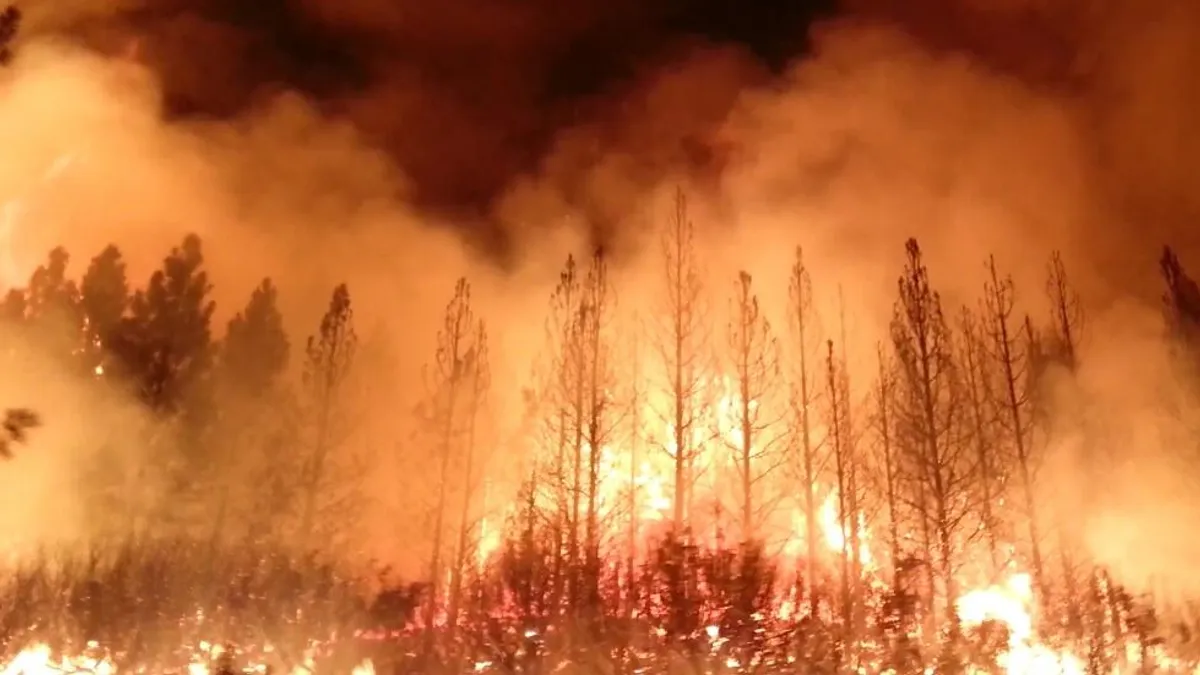Dive Brief:
- Two wildfire prevention measures in California could more tightly proscribe what materials contractors can build with, while limiting development overall, two builder advocacy groups said.
- Gov. Gavin Newsom unveiled a $536 million plan last week to prevent and fight wildfires in the Golden State, including calls for building fire-resistant structures, "fire-hardening" existing buildings and reviewing planning, zoning and development processes at the outskirts of communities in the so-called wildland-urban interface.
- SB 12, a bill introduced in December by state Sen. Mike McGuire that would require municipalities to create fire safety standards prior to permitting development in high fire risk areas, passed a key California Senate committee in late March. "We must change the way we build in high fire risk zones, and if certain commonsense health and safety requirements can’t be met, we shouldn’t be building at all," McGuire said in a statement introducing the bill.
Dive Insight:
Newsom’s plan was approved by lawmakers Monday, and he is expected to sign it into law today. SB 12 is scheduled for another hearing later this month.
Building groups say that while it's critical to combat the conflagrations that have plagued the state in recent years, the plans are using blunt tools to get the job done.
"The problem is we have had these devastating fires, and the answer becomes an either-or scenario, instead of an and-both solution," said Peter Tateishi, CEO of the Associated General Contractors of California. "They’re kind of saying, 'We’re tired of fighting the fires, so we’ll just restrict development altogether.'"
He’s also worried about further building material requirements being imposed on contractors. While the two state initiatives are aimed at building with fire-resistant materials, a recent motion adopted by the Los Angeles City Council would restrict the use of light lumber and wood framing construction in much of the city in the name of fire safety.
"If you’re going to say you can only use steel or cement-type structures in some of these areas, that’s a different kind of build with significant costs associated with it," Tateishi said. "That can become cost prohibitive for whether it pencils for developers."
For Dan Dunmoyer, CEO of the residential-focused California Building Industry Association, a focus on prohibiting development in the wildland-urban interface — the edges of towns and cities — essentially puts a wall around growth.
"If we build new homes on the edge of L.A., the homes that were already there before we build are already in a fire-prone area," Dunmoyer said. "That community already exists."
New California homes, which by code require fire suppression sprinkler systems on the interior, have become more fire-resistant in recent years through use of materials like asphalt shingles, cement fiber siding and better eave designs, he said.
He claimed builders already have an arduous review process for new development that’s reviewed by local fire officials who dictate fire breaks around developments, roads that can handle firefighting vehicles and well-planned ingress and egress routes.
"The current requirements are aggressive and sufficient," Dunmoyer said. "Current codes have proven themselves viable and beneficial."
A 'no-growth strategy'
Speaking to SB 12, Dunmoyer said while the trend has moved toward denser urban infill development, building proposals in urban areas of the state can often get blocked by local residents who use the California Environmental Quality Act as a shield to slowing development in their neighborhoods. And in a post-COVID-19 world, demand for housing has moved to the outskirts, the very areas the proposals target for limiting development.
"The goal is to make it harder to build housing outside of the urban corridor," Dunmoyer said. "It’s really a no-growth strategy."
And of course, residential development almost always precedes commercial development in the form of retail, restaurants and entertainment venues.
"We follow residential," Tateishi said. "You stop people from living there, and no commercial development is going to happen out there, either."
But Newsom argued action has to be taken.
"If you don’t believe in climate change, if you don’t believe in science, you believe your own damn eyes," Newsom said at an event in Fresno last week. "Something is happening as it relates to the issue of climate that’s exacerbating conditions and making the challenge of wildfire suppression and prevention that much more ominous."













